Circuit-Zone.com - Electronic Projects
Posted on Saturday, August 22, 2009 • Category: Test and Measurement
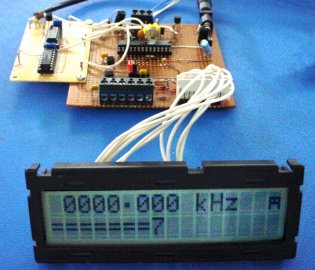
This is a simple, inexpensive and versatile frequency counter with LCD display and some special extra features.The counter contains only three inexpensive ICs (well, add a regulator and three transistors), and operates from 6 - 15V DC at about 25mA. The most expensive single item is the LCD display, which is an industry standard 16 x 2 dot matrix module, which can often be found used or at bargain prices.
Posted on Thursday, August 20, 2009 • Category: Battery Chargers
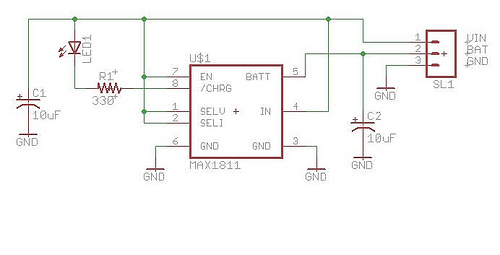 This is a MAX1811 based USB charger that can handle both Lithium Ion and Lithium Polymer 3.7V battery. It requires very few external components and provides ability to select between 4.1v and 4.2v battery regulation for different types of LiPo batteries. You can select between either 100mA and 500mA current charging mode and LED provides the status of the charging.
Posted on Thursday, August 20, 2009 • Category: Battery Chargers
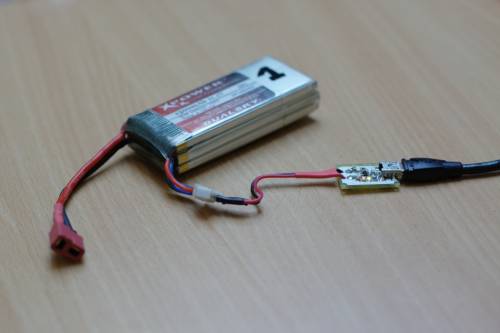 The MAX1551 and MAX1555 charge a single-cell 3.7V lithium-ion LiPo battery from both USB and AC adapter sources. They operate with no external FETs or diodes, and accept operating input voltages up to 7V.
On-chip thermal limiting simplifies PC board layout and allows optimum charging rate without the thermal limits imposed by worst-case battery and input voltage. When the MAX1551 and MAX1555 thermal limits are reached, the chargers do not shut down, but progressively reduce charging current.
The MAX1551 includes an active-low POK output to indicate when input power is present. If either charging source is active, active-low POK goes low. The MAX1555 instead features a active-low CHG output to indicate charging status.
With USB connected, but without DC power, charge current is set to 100mA (max). This allows charging from both powered and unpowered USB hubs with no port communication required. When DC power is connected, charging current is set at 280mA (typ). No input-blocking diodes are required to prevent battery drain.
The MAX1551 and MAX1555 are available in 5-pin thin SOT23 packages and operate over a -40°C to +85°C range.
Posted on Thursday, August 20, 2009 • Category: Battery Chargers
 This is a simple to build charger for single 3.7V lipo battery. The heart of the charger is TL431 shunt regulator that controls the incoming current. Charger comes with a convenient charging LED indicator. As charging current goes down so does the intensity of the LED.
Posted on Wednesday, July 8, 2009 • Category: Robots
 The PSoC Range Finder is a simple, inexpensive ultrasonic distance meter that requires only the PSoC device, two 40-kHz ultrasonic transducers, two resistors, and two capacitors. Typical applications include positioning for robotics, generic distance measurement, and liquid-level measurement without contact.
Posted on Wednesday, July 8, 2009 • Category: Counters / Frequency Meters
 An AVR controller can be used as a counter, although it is a bit more involved than with a PIC. The reason is that a PIC (at least the 16F84) has an asynchronous counter input. This input will handle frequencies up to app. 40 MHz. AVR's have a synchronous counter input which is sampled with the clock frequency, so it cannot measure frequencies over half the clock frequency. So, when using a 4 MHz clock, input frequencies must be lower than 2 MHz. Use 40% of the clock frequency to be on the safe side.
The input frequency can be measured by starting an AVR counter. Wait some predetermined time and then stop the counter. Read the counter register, account for the measurement time, and you know the frequency. This sounds simple enough. Things get a little more complicated if you use an external (to the AVR) prescaler to measure higher frequencies. A prescaler can be seen as a counter itself, that produces an output pulse for every n counts of input pulses. Even if this external prescaler has not counted up to its limit, you will want to know this count value, because it adds to the AVR count value to get a resulting counter with more bits.
An example: the AVR internal counter is 16 bits. It can count up to 65536 before overflowing to 0. If you use an external 14-bit counter (a 4020) as prescaler, it will increment the internal AVR counter at every 16384th input pulse. If you know the value of the 14-bit counter after the measurement time, you have effectively a 30-bit counter:
Posted on Wednesday, July 8, 2009 • Category: Remote Control
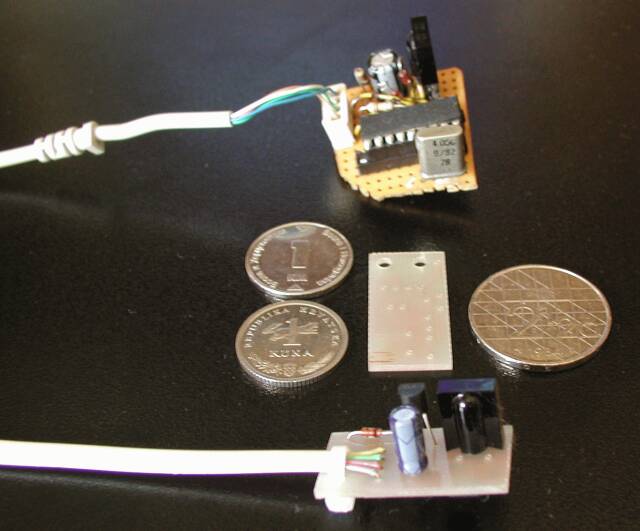 The UIR is a device that enables you to control your PC with ANY remote controller you have (TV, VCR, CD or Stereo). Original hardware & software was designed by Martinus & Ties Bos. You should check their site first. There it was, now it has either moved or is unavailable. In this article you can find improved and simplified hardware scheme, software & hints for building the device.
The device is very simple: minimal version uses only 3 components! So if you are not planning a big serial production you will build it on experimental (universal) circuit board. This is the most correct schema:
Posted on Wednesday, July 8, 2009 • Category: Robots
 The circuit uses two PWM channels of ATmega8 for controlling the speed and direction (reverse, forward) of the car, based on the command received from the IR remote. Here, a Sony TV remote was used. The IR codes were received by using TSOP1738 IR detector from Vishay.
Posted on Wednesday, July 8, 2009 • Category: AVR
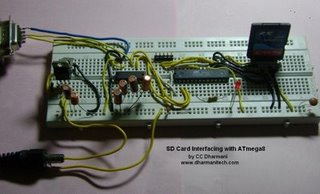 Here is my project on interfacing of SD Card (microSD). MicroSD cards are available very cheap nowadays, a great option for having a huge memory in any embedded system project. It is compatible with SPI bus, so interfacing is easy. SD card adapters are also easily available in market, so one can easily make an bread-board adapter by soldering few pins on it.
In this project, I've used 1GB microSD card from sandisk (later on tested with transcend card also) The microcontroller is AVR ATmega8 running at 8Mhz internal clock. MAX232 is used to interface the circuit with PC for monitoring the data. A 3.3v supply is used for powering the mega8, microSD and max232.
Posted on Tuesday, March 24, 2009 • Category: Audio Attenuators
 The circuit provides both audio volume and input channel selection. A stepwise volume control is implemented with a set of tiny relays and RN60D / RN55D Dale resistors. In a high-end audio system, a noticeable sound improvement over potentiometers is obtained, also compared to 'audio grade' potentiometers. Its IR remote control provides convenience over solutions with stepped attenuator rotary switches. The sealed relays will maintain contact quality over a practically endless lifetime. The design represents a audio 'preamplifier' of top-class sonic quality, in a compact and affordable implementation.
Compact and simple circuit with just 6 tiny relays implement a 64-step logarithmic stereo attenuator. The 64 steps of 1.0dB together span a 63dB audio attenuation range. By avoiding any active electronics, a very clean and open sound is maintained.
An IR receiver allows remote control. The IR 'eye' and a numeric display are on a small front-mount printed circuit board, separate from the relay board. The device can learn and store your favorite key codes. The controller understands the popular Philips 'RC5' protocol, Philips' newer 'RC6' protocol, and Sony's SIRC protocol. This also ensures interoperability with all 'generic' IR-controllers.
Circuit-Zone.com © 2007-2025. All Rights Reserved.
|